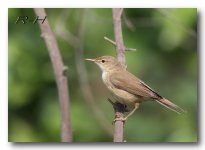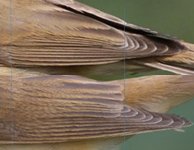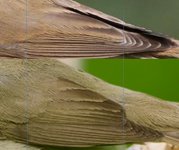-
Welcome to BirdForum, the internet's largest birding community with thousands of members from all over the world. The forums are dedicated to wild birds, birding, binoculars and equipment and all that goes with it.
Please register for an account to take part in the discussions in the forum, post your pictures in the gallery and more.
You are using an out of date browser. It may not display this or other websites correctly.
You should upgrade or use an alternative browser.
You should upgrade or use an alternative browser.
Blyth's or Reed Warbler (1 Viewer)
- Thread starter RASHED
- Start date
More options
Who Replied?Valéry Schollaert
Respect animals, don't eat or wear their body or s
What a gorgeous photo! As far as I know Blyth's, it looks like one with long bill and fairly short pp...
Valéry Schollaert
Respect animals, don't eat or wear their body or s
Also, the bird looks too richly coloured for Blyth´s, fairly dark alula, etc...
That was my first impression (but I saw only one Blyth's). However, browsing the net, I've found several similar individuals (including one accepted for France photographed by Aurélien Audevard) so probably not mis-identified...
I commented also to keep track of this interesting and nice bird. Hope to read more comment.
KenM
Well-known member
Looks like a Reed warbler to me. The emargination on p3 should fall well short of the secondary tips on a Blyth´s . Also, the bird looks too richly coloured for Blyth´s, fairly dark alula, etc...
The fact that the emargination on P3 falls ''just'' within the bunched secondaries/tertials was a concern to me..however the pp (62.5%) of overlying tertials is..I believe outside the norm for A.scirpaceous?
Jane Turner
Well-known member
You'd quite like to see a 4th or even 5th primary emargination of BRW too.
KenM
Well-known member
You'd quite like to see a 4th or even 5th primary emargination of BRW too.
Agreed.. certainly might be construed as borderline..one way or the other.
Tib78
Well-known member
The fact that the emargination on P3 falls ''just'' within the bunched secondaries/tertials was a concern to me..however the pp (62.5%) of overlying tertials is..I believe outside the norm for A.scirpaceous?
Ken,
The primary projection does not look very long on this picture, that's true. However it should be noted that the way the bird holds its wings ("bent inwards" if that makes any sense) is perhaps misleading and render the estimation of the PP somewhat uncertain. In any case, the PP looks shorter than on an average Eurasian reed.
Yet, considering all the other features visible on this truly excellent photograph, namely:
- fairly prominent eye-ring
- richer rufous tones to the face, wings, uppertail and tighs (and lack of olive tones altogether)
- tertial pattern more contrasting than on Blyth's
- alula's dark even on the outer web
- position of the emargination on p3, compare: http://www.pbase.com/image/98642769 (note emargination on p3/p4 and even slightly present on p5)
- lack of emargination on p4 (that's just a small notch on the outer web of the feather on the subject bird, not an emargination)
...I think it's a relatively straightforward A.scirpaceus.
Jane Turner
Well-known member
KenM
Well-known member
My first impressions although appearing more rufous than one might expect for BRW, I was somewhat influenced by the apparent Atypical pp on this individual. Albeit emargination on 3 was not (well within the tertial range but..''just..'') I reasoned against A.scirp. on balance..probably incorrectly. However I'm acutely aware of how posture can alter wing formula, and how lighting can alter the cosmetic appearance.
Jane Turner
Well-known member
Did I dream it... or aren't marsh Warbler style white primary tips a feature of fuscus.... which would make sense in the Middle east
Neil Morris
Well-known member
Did I dream it... or aren't marsh Warbler style white primary tips a feature of fuscus.... which would make sense in the Middle east
Indeed Jane. fuscus often moults later than scirpaceus, hence shows darker (fresher) remiges with pale Marsh-like tips, as in this bird.
For me, the emargination on P3 aligns more or less with the secondary tips and is thus good for fuscus, as is the very shallow emargination on P4. BRW usually has a deep emargination on P4.
The longer, almost decurved-looking bill is also typical of the fuscus I've seen in the Middle East. And those rich browns are highly unusual for a fresh BRW.
I'm with Jane and Tib78 - it's a Reed Warbler, probably ssp. fuscus.
A final point, the wing length of fuscus varies by the population and its particular migration distance. But even in the 'apparent' short(ish) pp in this shot (already analysed by Tib78), I can still see eight primary tips beyond the tertials.
Neil Morris
Well-known member
Why not a Marsh ? The bird is pale-legged and long-billed...
That's a very good question. But the legs are not pale enough, and the claws are blackish rather than being pale (yellowish horn); the plumage is too richly coloured, too many chestnut/rufous tones. And note that the tips of the longest tertials reach the secondary tips, rather than being longer and overlapping these. The bill is also wrongly coloured and shaped for a Marsh Warbler at this time of year.
You might like to compare with a Marsh Warbler i photographed in Qatar a few days ago: http://www.tarsiger.co.uk/qatar_pages/warbler_marsh_2013-04-28_1_page.htm.
Best wishes
KenM
Well-known member
ssp.fuscus as I understand, Winters in the gulf, unsure if the entire population does?
However if that is the case..then that might explain the shorter pp ,relative to the required migration distance? FWIW Collins mentions that ssp.fuscus are slightly darker/greyer above and paler below..ie more like Marsh, BRW, Olivaceous and Savi's.
However if that is the case..then that might explain the shorter pp ,relative to the required migration distance? FWIW Collins mentions that ssp.fuscus are slightly darker/greyer above and paler below..ie more like Marsh, BRW, Olivaceous and Savi's.
Neil Morris
Well-known member
ssp.fuscus as I understand, Winters in the gulf, unsure if the entire population does?
However if that is the case..then that might explain the shorter pp ,relative to the required migration distance? FWIW Collins mentions that ssp.fuscus are slightly darker/greyer above and paler below..ie more like Marsh, BRW, Olivaceous and Savi's.
Yes, fuscus is typically paler, colder (greyer) brown than scirpaceus, thus closer to dumetorum. However, the difference to scirpaceus is greatest in the autumn; spring birds can be very close to scirpaceus.
Users who are viewing this thread
Total: 2 (members: 0, guests: 2)






